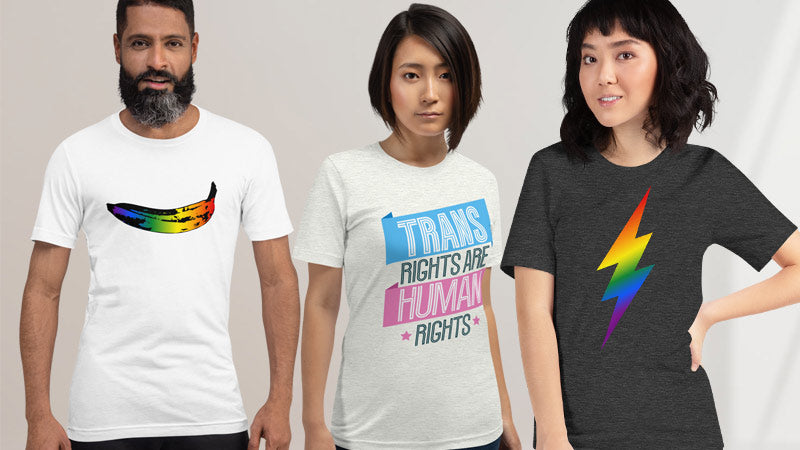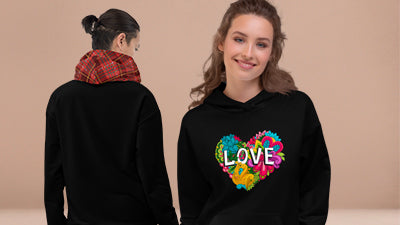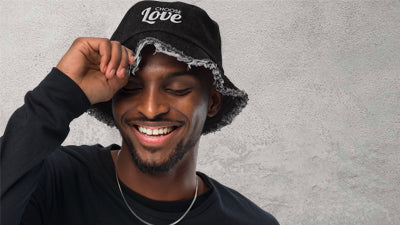Pride Flag Colours And Meanings, Your Guide To LGBTQ+ Flags

What Are Your Pride Flag Colours?
This is an important question, because here at The Rainbow Stores we have an awful lot of things with pride flag colours on. There is a dizzying array, sometimes up to five or six for the same group. And then there's the subcategories and intersectional identities. Many of us sit in multiple different gender identity or sexual attraction groups in the LGBTQ+ community, so there may be many that represent us.
The pride flag universe is an organic and constantly evolving space, with flags for subgroups appearing, disappearing or being amended all the time. And constant debate over meanings and whether this or that design is inclusive enough. In some cases adopted flags get rejected almost overnight when their creator says something abhorrent or exclusionary of another group.
You may think it's not important. That it's just a flag. But it is important. Because these beautiful, multicoloured, banners have a significant roll in increasing visibility and creating a focal point to rally around.
And to help people within each of the groups, subgroups and subcultures in our vibrant, wonderful and exciting community to identify, understand that they're not alone and feel they have meaning.
So we thought it wise to write you a handy guide to the different flags and symbols, how they came about and any nuanced meaning behind them, that way you can be sure that you buy the one that's right for you.
There are literally hundreds, so we have tried to create a comprehensive list of the main ones and the most popular subcategories. We hope this also helps you to recognise other flags when you're at Pride or other events. And getting a better understanding of LGBTQ+ history is good for all of us.
We'll cover the most visible flags/identities first and look how they've evolved, and then talk about the others in alphabetical order.

The First Rainbow Pride Flag by Gilbert Baker
This is where it all began. There were flags for the community before this, but nothing designed to unite us all. The first Pride Flag was designed by artist and costume designer Gilbert Baker in 1978 for the San Francisco Gay Freedom Day (after he was challenged to do so by Harvey Milk). It had eight stripes and was meant to symbolise hope and liberation and represent the diversity of the community. The colours were included for their meaning: Pink for sexuality; Red for life; Orange for healing; Yellow for sunlight; Green for nature; Turquoise for Art; Indigo for Serenity; Violet for Spirit.
Read the Origin story of the Gilbert Baker Rainbow Pride Flag
The Seven Stripe Rainbow Pride Flag
The first iteration of the flag came about within a year because of practical reasons. The original flags had been hand dyed, but when Gilbert Baker came to produce them in numbers he realised that he needed commercially dyed fabric and found that the pink fabric that was needed for the top stripe was in such short supply that it wasn't practical going forward. So it was removed and the flag was reduced to seven stripes. You almost never see this flag associated with the LGBTQ+ community now.

Classic Rainbow Pride Flag
In 1979 the flag changed again. The reason this time was partly functional and party ceremonial, because many of the flags were hung vertically from lamp posts on Market Street in San Francisco, and with seven stripes centre stripe was not seen. So it was decided to drop down to six stripes, and the turquoise and indigo colours were combined into royal blue. This is the classic Pride Flag that we know today. Although the tones of the various colours are constantly adapted and altered. The colours now represented: Red for life and sexuality; Orange for healing and friendship; Yellow for vitality and energy; Green for serenity and nature; Blue for harmony and artistry and violet for spirit and gratitude.

Philadelphia Rainbow Pride Flag
In 2017 the city of Philadephia in the US created a new pride flag with the addition of the black and brown stripes at the top. This was done because it was felt the LGBTQ+ community needed to purposefully include black and indigenous people of colour within the community and combat racism.

Progress Pride Flag
In 2018 we saw another evolution of the flag. Created by Daniel Quasar it moved the black and brown stripes into a chevron on the left and added in the pink, white and blue stripes from the Trans Pride flag. This version has seen significant usage in the UK following the COVID pandemic as a Rainbow flag (albeit with the full seven colours of the rainbow) became appropriated by the National Health Service (NHS) in the UK. So it became difficult to tell if someone wearing the classic flag was LGBTQ+ or supporting the NHS.

Intersex Inclusive Progress Pride Flag
Designed in 2021 by Intersex activist Valentino Vecchietti to help raise awareness of Intersex people, the Intersex-Inclusive Progress Pride flag incorporates the yellow background and purple circle of the Intersex flag into the white area of the Progress flag.

Our Rainbow Pride Flag Collection
Straight Ally Pride Flag
For those who support our fight for equality there is the ally flag. The classic LGBTQ+ Rainbow Pride flag colours are shown as an A (for Ally) within a black and white striped background, which represents heterosexual and cisgendered people. The flag was created at some point in the early 2000s but the exact origin is not known.

Lesbian Pride Flag
In 2019 Emily Gwen designed this seven stripe Lesbian flag. With the upper pink stripes replaced by orange from a Butch lesbian flag that had emerged. This flag is intended to be more inclusive of butch, trans and gender non conforming people. On her Twitter feed Emily explained the meaning of the stripes from the top as: Dark orange for gender non-conformity; Mid orange for independence; Light orange for community; White for unique relationships to womanhood; Light pink for serenity and peace; Mid pink for love and sex; Dark pink for femininity. Find out more about Lesbian lives in our Lesbian Visibility Week blog.

Lesbian Pride Flag (Five Stripes)
Based on the seven stripe flag this simplified version was created after some felt the seven stripes were too complicated. Two versions, with five and three stripes were put to a Twitter poll on @lesbianflag to find an official flag and the five stripe flag won. The meaning of the stripes are, from the top: Transgressive womanhood, community, gender non-conformity, freedom and love.

Pink Lesbian Pride Flag
Created in 2015 this Lesbian Pride flag was derived from an original 2010 version which had a lipstick mark on the top left corner and was known as the Lipstick Lesbian Flag. This variation, without the lipstick mark, is now seen as representing femme lesbians. Many in the community feel that any variation on this flag doesn't represent butch lesbians and so it was inevitable that alternatives would be created to have a wider representation.

Labrys Lesbian Pride Flag
The very first lesbian flag, designed in 1999. It was actually designed by gay man and graphic designer Sean Campbell, and includes an inverted black triangle (which was the symbol lesbians were forced to wear by the Nazis in World War II) with a white labrys, or double edged axe, inside it, which was a weapon associated with the mythological Amazons as well as a Mediterranean symbol of matriarchal power. It relates to lesbian empowerment, feminism and strength. Some trans exclusionary radical feminist groups have tried to claim the labrys by this flag was never about transphobia. The reason it wasn't that widely adopted was probably more to do with it being designed by a man.

Gay Men's Pride Flag
The original Gay Men's Pride Flag was seen as being too blue and also too much of a reflection of the pink lesbian flag, and so not inclusive enough. As a result it was redesigned in 2019 by Tumblr member gayflagblog with a green at the top and blue and purple shades at the bottom. This was seen as being more inclusive of trans men. As with the Lesbian flag it was later given a simplified five stripe alternative which removed the middle green and blue stripes.

Gay Men's Pride Flag (Original version)
Originally created in the mid 2010s to combat homophobia by activist Valentin Belyaev and first shown in a group on VKontakte and Tumblr. The shades of azure and blue are meant to reflect the diversity of the gay community and was created as an opposite of the pink lesbian flag, which was gaining popularity at the time.

Bisexual Pride Flag
Created in 1998 by a group led by bisexual activist Michael Page. In the original meaning the pink stripe was intended to represent same sex attraction, the blue stripe was attraction to the opposite sex and the purple stripe was a combination of both colours and so is an attraction to both sexes. However current interpretations have changed and the pink is now seen as an attraction to female or femme people, purple to non binary people and blue to male or masculine people. The Bi+ identity was also created to move away from the idea that bisexuality focussed on the binaries. Find out more about Bisexuality in our Bisexual Awareness Week Blog

Transgender Pride Flag
Designed in 1999 by trans activist Monica Helms, the transgender Flag represents colours generally associated with baby boys and baby girls, plus a white stripe for those who are transitioning or consider themselves to have a neutral or undefined gender. Helms said that “The pattern is such that no matter which way you fly it, it is always correct, signifying us finding correctness in our lives.”. Find out more about trans people in our Trans Awareness Week blog

Cisgender Trans Ally Flag
A play on the LGBTQ+ ally flag, but exchanging the rainbow flag for the trans flag. The origin of this flag is currently unknown.

Queer Pride Flag
Very few people even know there’s a Queer Pride Flag, but this beauty is one of our favs. Created in 2015 it represents all aspects of queerness for people who choose that label, which has come to represent so many that don’t feel they fit in other identities. The pink and blue stripes represent same-gender attraction while the orange and green stripes stand for Non-Binary and gender non-confirming identities. The black and white stripes stand for Asexual, Aromantic, and Agender people.

SEXUAL ORIENTATION FLAGS A-Z
Aromantic Pride Flag
The flag for people who experience limited or no romantic attraction was created in 2014 by Cameron and unveiled on their Tumblr page. The two green stripes represent the Aromantic spectrum. The white stripe represents the importance of platonic relationships and non-romantic love. The black and grey stripes represent the sexuality spectrum, recognising the diversity of the Aromantic community.

AroAce Pride Flag
At last count there were more than 11 AroAce flags, but the one that has become popularly accepted is the ‘sunset’ flag, created by Tumblr user aroaesflags in 2018. The orange stripe represents the whole AroAce community, as orange is a colour between Ace purple and Aro green. Yellow stands for love and relationships outside of the conventional ideas. White represents wholeness, and blue is another colour between green and purple and there are two to represent a spectrum of AroAce identities.

Asexual Pride Flag
This flag is one of the few pride flags that was created not by an individual but by the community themselves in 2010. The flag was chosen by vote from a choice presented to the AVEN community (Asexual Visibility and Education Network). The meaning of the colours is: black for asexuality, Grey for other asexual-spectrum identities including demisexuality and greyasexuality; White for allosexuality, and purple for the asexual community. Read our blog on What It Means To Be Asexual .

Demisexual Pride Flag
Demisexuality falls under the Asexual spectrum and represents those who need to feel a strong emotional bond to develop sexual attraction to someone. The colour meanings are: Black for the absence of sexuality; grey for demisexuality; white for sexuality and purple for community.

Pansexual Pride Flag
The Pansexual flag was designed in 2010 by Queer Non-binary person Jasper V. as a way to differentiate Pansexuality from Bisexuality. Pansexuality is sexual, romantic, or emotional attraction towards people of all genders, regardless of their sex or gender identity. The pink in the flag represents people who are feminine, the blue people who are masculine and the yellow is everyone in between. Read more about Pansexuality in our Pansexual Visibility Day blog.

Polysexual Pride Flag
Polysexual refers to those who are sexually attracted to people of multiple, but not all, genders. The flag was designed in 2012 by Tumblr user Samlin and is similar to the Bisexual and Pansexual flags as they all fall into the area of multi-sexual attraction. Pink represents an attraction to those who identify as female; Blue to those who identify as male and the green represents those who are attracted to non-binary people and others who do not identify as either male or female.

GENDER IDENTITY / GENDER EXPRESSION FLAGS A-Z
Agender Pride Flag
Initially seen in 2014 and created by New York artist Salem in order to increase visibility. The black and white stripes represent the absence of gender, the grey stripes represent semi-genderlessness and the green stripe represents non-binary genders. Green is outside the spectrum of blue-pink which is seen as the gendered spectrum. Read more about what it means to be Agender in our blog post.

Bigender Pride Flag
The original Bigender flag from 2015 was dropped by the community after its creator was found to have some very problematic beliefs and actions. The updated flag here is similar but the lavender and white stripes are reversed. The pink shades represent female gender and blues represent male gender. Their separation and equal size “represent a sense of separation, yet coexistence between masculinity and femininity”. The lavender represents Non-Binary identities and white represents neutral genders, such as Agender.

Gender Fluid Pride Flag
This five striped flag was created in 2012 by JJ Poole as a symbol for those who's gender expression or both change over time. The means of the colours are as follows: The pink stripe represents femininity, the white stripe represents all genders, the purple stripe represents both masculinity and femininity, the black stripe represents the lack of gender and the blue stripe represents masculinity. Read more about Gender Fluidity in our Gender Fluid Visibility Week blog.

Genderqueer Pride Flag
Video artist and photographer Marilyn Roxie designed this three stripe flag from the Genderqueer community in 2010. This identity is hard to define, but has been explained by The Transgender Language Primer as “a gender that is neither man nor woman, possibly a mix of genders, and possibly fluid”. The meaning of the three stripes is: Lavender, a mix of blue and pink, represents androgyny. Although lavender has also been associated with queerness. White represents people who are Agender, and the dark green is meant to represent those whose identities are defined outside of the binary.

Intersex Pride Flag
Designed in 2013 by Morgan Carpenter for those with ambiguous sexual characteristics. The Intersex Pride Flag moves away from stripes to make it incredibly easy to identify. The yellow and purple colours are used because they are neither blue nor pink and yellow especially is seen as an Intersex colour. The circle is explained on the page launching the flag as, "unbroken and unornamented, symbolising wholeness and completeness, and the right to be who and how we want to be.” Find out more in our Intersex Awareness Day blog.

Non-Binary Pride Flag
First seen in 2014 and designed by Kye Rowan the non-binary pride flag includes four stripes with the yellow representing being outside of the traditional gender identities, white for people who see themselves as having many genders (as this is the combination of all colours). The purple stripe represents fluidity of gender and those whose gender sits between male and female and black represents people who are agender (as black is the absence of colour). You can find out more about Non-Binary people in our Non-Binary Peoples Day blog.









